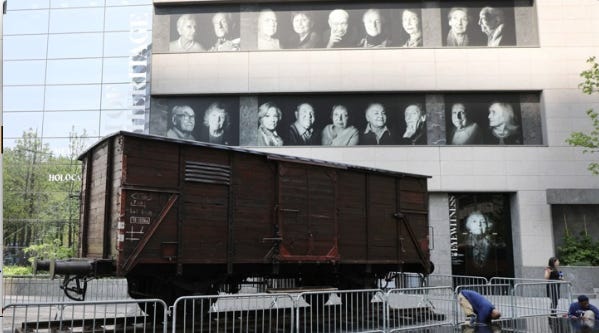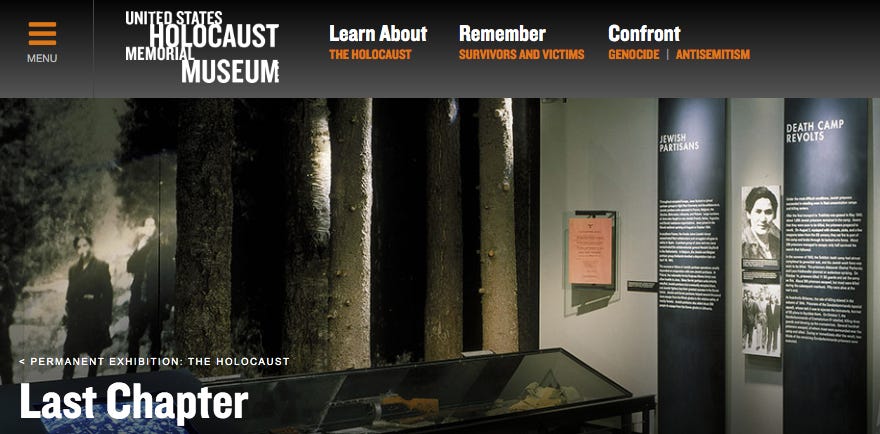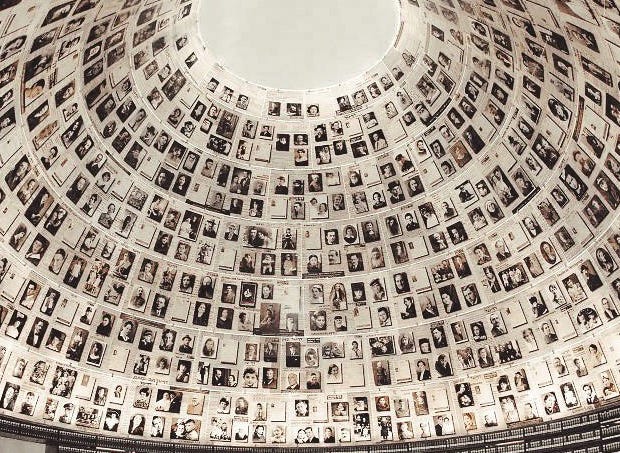
Dara Horn’s critique of a recent exhibition at the Museum of Jewish Heritage in downtown Manhattan (“Auschwitz Is Not a Metaphor,” The Atlantic, June 6, 2019) is good as far as it goes, but she missed perhaps the biggest weakness of such shows: the need to frame the Holocaust as a self-contained narrative with a beginning, middle, and end. “Telling the story” might be a useful framework for curators and a satisfying drama for the audience, but it drains the genocide of European Jewry of its evil, its devastating power, and its potential meaning.
To see this more clearly, compare the U.S. Holocaust Memorial & Museum in Washington, D.C., with Yad Vashem, Israel’s memorial to the six million.
At the Holocaust Museum, visitors walk through a sequence of galleries that tell the story decade by decade.
The 1920s: turmoil in Germany after WWI... economic collapse... the decline of the Weimar Republic…
The 1930s: the rise of Hitler & the Nazis... anti-Jewish laws... Kristallnacht... European conquest...
The 1940s: Auschwitz & the genocide of European Jewry... but then the Allies come to the rescue... defeat the Nazis... and liberate western Europe.
Museum visitors then proceed to a quiet, high-ceilinged sanctuary for (optional) prayer and meditation... then to the museum book store... then out to Independence Avenue for hot dogs & Sno-Cones. The museum’s “story” ends with the good guys winning, but the whole experience feels painfully self-contained: Nazis defeated! Now back to your regular programming.
(Yes, the Museum includes all sorts of exhibits and programs about preventing genocide today, all around the world. But the need for a story — our demand for some narrative structure to contain this horror and maybe even explain it— can’t be denied.)
Compare that experience with a visit to Yad Vashem Holocaust Remembrance Center in Jerusalem — at least Yad Vashem as it was back in the 1980s. My memory (which may be a bit foggy) is the Center did not attempt to present the Holocaust as a story. Instead, it just hit you between the eyes: Six million Jews were slaughtered by the Nazis. Here are some pictures.
As visitors move from the memorial’s interior, with its black-and-white photographs of the Holocaust's victims... past the flicker of the memorial’s Eternal Flame... out the doors... and into the blinding Jerusalem sun, it dawns on you: Whatever “story” was underway in 1945 isn’t over. It’s still going on. History hasn’t stopped. Evil has not been vanquished or even contained. It still hovers, in the darkness and the light. And the human story, such as it is, stumbles on.
The story told by the Holocaust Museum permits us, as we exit the building, to return to our own lives. It lets us escape both history and responsibility. It gives us a pass because the Allied forces were victorious. Because “Never Again.” Because we know better now.
Yad Vashem leaves almost no room for that escape. Instead, it reminds us that history is still underway. That our collective narrative — the story of the Jews and of humanity — is still being written. And that in this drama, you and I have speaking parts and an important role to play.





I think that in recent years and par for the (cultural) course, Yad Vashem has tilted more toward traditional storytelling in last few decades. I have never been to USHMM, but I understand it is rather American-centric, which matches your description of the chronological journey with a beginning, middle and end (with snacks.) In Yad Vashem, you emerge onto a balcony framed by the darkness of the museum, with a stunning view of Jerusalem. Of refuge. Of home. It’s a powerful Jewish/Israeli story arc - which is often abused and misused by Israeli politicians whom we shall not dare to name.
I had the honor of being at Yad Vashem in 1984. The piles of shoes, clothing and hair of the victims, shaved off their heads to be used and sold for luxury wigs... These images are with me ever since. Never again means never again.
Even if humanity hasn't learned its lessons from millenials of wars... ISRAËL WILL STAY ❣️